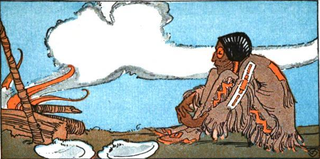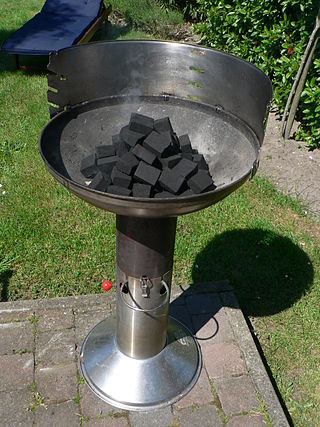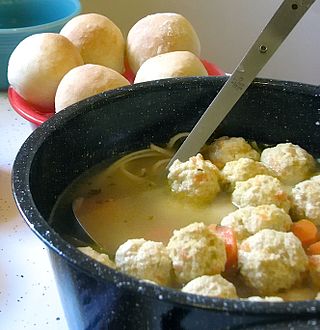
A pie is a baked dish which is usually made of a pastry dough casing that contains a filling of various sweet or savoury ingredients. Sweet pies may be filled with fruit, nuts, fruit preserves, brown sugar, sweetened vegetables, or with thicker fillings based on eggs and dairy. Savoury pies may be filled with meat, eggs and cheese or a mixture of meat and vegetables.
Diné Bahaneʼ, is a Navajo creation story that describes the prehistoric emergence of the Navajo as a part of the Navajo religious beliefs. It centers on the area known as the Dinétah, the traditional homeland of the Navajo, and forms the basis of the traditional Navajo way of life and ceremony. Throughout the stories the importance of cardinal points and the number four are emphasized in multiple aspects.

In Lakota mythology, Iktómi is a spider-trickster spirit, and a culture hero for the Lakota people. Alternate names for Iktómi include Ikto, Ictinike, Inktomi, Unktome, and Unktomi. These names are due to the differences in languages between different indigenous nations, as this spider deity was known throughout many of North America's tribes.

Malaysian cuisine consists of cooking traditions and practices found in Malaysia, and reflects the multi-ethnic makeup of its population. The vast majority of Malaysia's population can roughly be divided among three major ethnic groups: Malays, Chinese and Indians. The remainder consists of the indigenous peoples of Sabah and Sarawak in East Malaysia, the Orang Asli of Peninsular Malaysia, the Peranakan and Eurasian creole communities, as well as a significant number of foreign workers and expatriates.

The muskrat is a medium-sized semiaquatic rodent native to North America and an introduced species in parts of Europe, Asia and South America.

Harpadon nehereus is a species of lizardfish. Adults may reach a maximum length of 40 cm (16 in), but the usual size is around 25 cm (10 in).

Indirect grilling is a barbecue cooking technique in which the food is placed to the side of or above the heat source instead of directly over the flame as is more common. This can be achieved by igniting only some burners on a gas barbecue or by piling coals to one side of a charcoal pit. A drip tray is placed below the food to prevent fat from the food igniting and generating a direct flame. Indirect grilling is designed to cook larger or tougher foods that would burn if cooked using a direct flame. This method of cooking generates a more moderate temperature and allows for an easier introduction of wood smoke for flavoring.

In cooking and gastronomy, duck or duckling is the meat of several species of bird in the family Anatidae, found in both fresh and salt water. Duck is eaten in many cuisines around the world. It is a high-fat, high-protein meat rich in iron. Duckling nominally comes from a juvenile animal, but may be simply a menu name.

Domestic ducks are ducks that have been domesticated and raised for meat and eggs. A few are kept for show, or for their ornamental value. Most varieties of domesticated ducks, apart from the Muscovy duck and hybrids, are descended from the mallard, which was domesticated in China around 2000 BC.

Coyote is a mythological character common to many cultures of the Indigenous peoples of North America, based on the coyote animal. This character is usually male and is generally anthropomorphic, although he may have some coyote-like physical features such as fur, pointed ears, yellow eyes, a tail and blunt claws. The myths and legends which include Coyote vary widely from culture to culture.

Ugandan cuisine consists of traditional and modern cooking styles, practices, foods and dishes in Uganda, with English, Arab, and Asian influences.

Barbecue varies by the type of meat, sauce, rub, or other flavorings used, the point in barbecuing at which they are added, the role smoke plays, the equipment and fuel used, cooking temperature, and cooking time.

Goose Pond is a 625-acre (2.5 km2) water body located in Grafton County in western New Hampshire, United States, in the towns of Canaan and Hanover. It is considered a great pond by the state of New Hampshire. The lake has 6.3 miles (10.1 km) of shoreline, and is approximately 3 miles (5 km) long by 0.5 miles (0.8 km) wide. All but the northernmost end of the pond is in the town of Canaan. The average depth of the pond is approximately 10 feet (3.0 m), with the deepest part approximately 35 feet (11 m). The lake is part of the Mascoma River watershed, flowing to the Connecticut River.

Paul Goble was a British-American writer and illustrator of children's books, especially Native American stories. His book The Girl Who Loved Wild Horses won a Caldecott Medal in 1979.
Go Go Gophers is an animated series set in the Old West that appears as a 4-5 minute long segment within 48 episodes of the Underdog TV series. It was then spun off as a separate series on CBS that aired from September 14, 1968 to September 6, 1969. However, the episodes were just repeats of the 48 segments that aired on the Underdog series. The show also shared with Space Kidettes on Saturday morning television in 1967. The show was produced by Total Television.
Blood Clot Boy is a figure in the mythologies of several Native American tribes, including the Blackfoot, Arapaho, Santee, and Lakota. He is typically depicted as being born after a clot of blood from a buffalo was placed in a pot of boiling water, although the manner in which Blood Clot Boy is given life can vary between versions of the story.
The Great Race is a Native American legend surrounding the Red Racetrack, a ring shaped depression surrounding the interior of the Black Hills. The legend tells the story of when buffalo and man raced each other to establish order in the universe. The stories differ from tribe to tribe but the constant theme is that man established supremacy over the buffalo. This story is also associated with the origins of the Sun Dance and the Medicine Lodge. Taking place in July, Sun Dance is four to eight days of dancing in order to try to connect with the Great Spirit.

A meatball is ground meat (mince) rolled into a ball, sometimes along with other ingredients, such as bread crumbs, minced onion, eggs, butter, and seasoning. Meatballs are cooked by frying, baking, steaming, or braising in sauce. There are many types of meatballs using different types of meats and spices. The term is sometimes extended to meatless versions based on legumes, vegetables, mushrooms, fish or other seafood.
American Indian Stories is a collection of childhood stories, allegorical fictions and essays written by Sioux writer and activist Zitkala-Ša.

Zambian cuisine offers a range of dishes, which primarily features nshima, a staple thick porridge crafted from maize flour, locally known as mealie meal. Nshima itself is quite plain, but it is typically accompanied by an array of traditional Zambian side dishes that introduce a spectrum of flavors to the meal.















